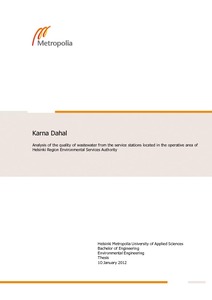Analysis of the quality of wastewater from the service stations located in the operative area of Helsinki Region Environmental Services Authority
Dahal, Karna (2012)
Dahal, Karna
Metropolia Ammattikorkeakoulu
2012
All rights reserved
Julkaisun pysyvä osoite on
https://urn.fi/URN:NBN:fi:amk-201202292688
https://urn.fi/URN:NBN:fi:amk-201202292688
Tiivistelmä
The objective of this thesis was to analyse the data of pollutant parameters for waste water from the service stations situated in the operative area of the Viikinmäki and Suomenoja WWTPs in the Helsinki Region Environmental Services Authority (HSY). The main reason for this analysis was that HSY wanted to know about the quality of waste water discharged from the service stations into the influent of its WWTPs.
The number of cars used in Finland is increasing day by day; hence, automatic car wash services as well as car washes by hand at home are likely to increase in the same proportion. Automatic car wash services in Finland are often located at service stations. Car wash operation does not need an environmental permit, but the wastewater produced from car washes needs to be treated before sending it to the municipal sewer network to protect the treatment equipments in the municipal WWTPs. The Viikinmäki and Suomenoja WWTPs are two WWTPs in Helsinki Region Environmental Services –Authority (HSY). The Viikinmäki WWTP treats about 270 000 cubic meters of daily flow of wastewater and the Suomenoja WWTP treats about 100 000 cubic meters of daily flow of wastewater.
The sources of pollutants in the wastewater of service stations are dirt from the surfaces of vehicles, from the different parts of vehicles and washing equipment, from yards of the service stations, and used chemicals from car washes and cleaning washing lines and oil spillages. There are various types of chemicals from different manufacturers used for car washes in Finland. The excessive amount of pollutants in wash water damages the sewer system, impairs the wastewater treatment processes and worsens the quality of waste water. The car wash must be equipped with sand separators, oil separators, and a combined sampling shaft and closing valve well. The design of the sewer network in the service stations also affects the treatment system in the service stations.
The analyses of data are solely based on the comparison between and within the old data from 2006 to 2010 and the new data obtained in 2011. The pollutant parameters that were analysed are pH, conductivity, suspended solids, BOD7, CODCr, total phosphorus, total nitrogen, heavy metals and total hydrocarbon (THC). The main target of the project was to analyse THC. The comparison of old and new data reveals that most of the service stations treat their wastewater properly and effectively, abiding by the rules of the HSY, however, there is always a need for an improvement in the quality.
The number of cars used in Finland is increasing day by day; hence, automatic car wash services as well as car washes by hand at home are likely to increase in the same proportion. Automatic car wash services in Finland are often located at service stations. Car wash operation does not need an environmental permit, but the wastewater produced from car washes needs to be treated before sending it to the municipal sewer network to protect the treatment equipments in the municipal WWTPs. The Viikinmäki and Suomenoja WWTPs are two WWTPs in Helsinki Region Environmental Services –Authority (HSY). The Viikinmäki WWTP treats about 270 000 cubic meters of daily flow of wastewater and the Suomenoja WWTP treats about 100 000 cubic meters of daily flow of wastewater.
The sources of pollutants in the wastewater of service stations are dirt from the surfaces of vehicles, from the different parts of vehicles and washing equipment, from yards of the service stations, and used chemicals from car washes and cleaning washing lines and oil spillages. There are various types of chemicals from different manufacturers used for car washes in Finland. The excessive amount of pollutants in wash water damages the sewer system, impairs the wastewater treatment processes and worsens the quality of waste water. The car wash must be equipped with sand separators, oil separators, and a combined sampling shaft and closing valve well. The design of the sewer network in the service stations also affects the treatment system in the service stations.
The analyses of data are solely based on the comparison between and within the old data from 2006 to 2010 and the new data obtained in 2011. The pollutant parameters that were analysed are pH, conductivity, suspended solids, BOD7, CODCr, total phosphorus, total nitrogen, heavy metals and total hydrocarbon (THC). The main target of the project was to analyse THC. The comparison of old and new data reveals that most of the service stations treat their wastewater properly and effectively, abiding by the rules of the HSY, however, there is always a need for an improvement in the quality.
